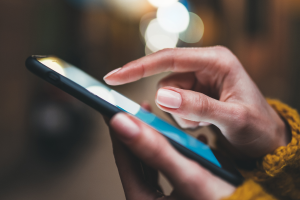
“Vishing” occurs when criminals cold-call victims and attempt to persuade them to divulge personal information over the phone. These scammers are generally after credit card numbers and personal identifying information, which can then be used to commit financial theft. Vishing can occur both on your landline phone or via your cell phone.
The term is a combination of “voice,” and “phishing,” which is the use of spoofed emails to trick targets into clicking malicious links. Rather than email, vishing generally relies on automated phone calls that instruct targets to provide account numbers. Techniques scammers use to get your phone numbers include:
Once vishers have phone numbers, they employ various strategies to deceive their targets and obtain valuable personal information:
To protect yourself from vishing scams, you should:
Staying vigilant and informed is your best defense against vishing scams. By verifying caller identities, being skeptical of unsolicited requests for personal information, and using call-blocking tools, you can significantly reduce your risk of falling victim to these deceptive practices. Additionally, investing in identity theft protection services can provide an extra layer of security. These services monitor your personal information for suspicious activity and offer assistance in recovering from identity theft, giving you peace of mind in an increasingly digital world. Remember, proactive measures and awareness are key to safeguarding your personal information against vishing threats.
The post How to Protect Yourself from Vishing appeared first on McAfee Blog.

My mother recently turned 80, so of course a large celebration was in order. With 100 plus guests, entertainment, and catering to organise, the best way for me to keep everyone updated (and share tasks) was to use Google Docs. Gee, it worked well. My updates could immediately be seen by everyone, the family could access it from all the devices, and it was free to use! No wonder Google has a monopoly on drive and document sharing.
But here’s the thing – hackers know just how much both individuals and businesses have embraced Google products. So, it makes complete sense that they use reputable companies such as Google to devise phishing emails that are designed to extract our personal information. In fact, the Google Docs phishing scam was widely regarded as one of the most successful personal data extraction scams to date. They know that billions of people worldwide use Google so an invitation to click a link and view a document does not seem like an unreasonable email to receive. But it caused so much grief for so many people.
Emails designed to trick you into sharing your personal information are a scammer’s bread and butter. This is essentially what phishing is. It is by far the most successful tool they use to get their hands on your personal data and access your email.
‘But why do they want my email logins?’ – I hear you ask. Well, email accounts are what every scammer dreams of – they are a treasure trove of personally identifiable material that they can either steal or exploit. They could also use your email to launch a wide range of malicious activities from spamming and spoofing to spear phishing. Complicated terms, I know but in essence these are different types of phishing strategies. So, you can see why they are keen!!
But successful phishing emails usually share a few criteria which is important to know. Firstly, the email looks like it has been sent from a legitimate company e.g. Microsoft, Amex, or Google. Secondly, the email has a strong ‘call to action’ e.g. ‘your password has been changed, if this is not the case, please click here’. And thirdly, the email does not seem too out of place or random from the potential victim’s perspective.
Despite the fact that scammers are savvy tricksters, there are steps you can take to maximise the chances your email remains locked away from their prying eyes. Here’s what I suggest:
Never respond to an unexpected email or website that asks you for personal information or your login details no matter how professional it looks. If you have any doubts, always contact the company directly to verify.
Make sure you have super-duper internet security software that includes all the bells and whistles. Not only does internet security software McAfee+ include protection for daily browsing but it also has a password manager, a VPN, and a social privacy manager that will lock down your privacy settings on your social media accounts. A complete no-brainer!
Avoid using public Wi-Fi to log into your email from public places. It takes very little effort for a hacker to position themselves between you and the connection point. So, it’s entirely possible for them to be in receipt of all your private information and logins which clearly you don’t want. If you really need to use it, invest in a Virtual Private Network (VPN) which will ensure everything you share via Wi-Fi will be encrypted. Your McAfee+ subscription includes a VPN.
Public computers should also be avoided even just to ‘check your email’. Not only is there a greater chance of spyware on untrusted computers but some of them sport key-logging programs which can both monitor and record the keys you strike on the keyboard – a great way of finding out your password!
Ensuring each of your online accounts has its own unique, strong, and complex password is one of the best ways of keeping hackers out of your life. I always suggest at least 10-12 characters with a combination of upper and lower case letters, symbols, and numbers. A crazy nonsensical sentence is a great option here but better still is a password manager that will remember and generate passwords that no human could! A password manager is also part of your McAfee+ online security pack.
Even if you have taken all the necessary steps to protect your email from hackers, there is the chance that your email logins may be leaked in a data breach. A data breach happens when a company’s data is accessed by scammers and customers’ personal information is stolen. You may remember the Optus, Medibank and Latitude hacks of 2022/23?
If you have had your personal information stolen, please be assured that there are steps you can take to remedy this. The key is to act fast. Check out my recent blog post here for everything you need to know.
So, next time you’re organising a big gathering don’t hesitate to use Google Docs to plan or Microsoft Teams to host your planning meetings. While the thought of being hacked might make you want to withdraw, please don’t. Instead, cultivate a questioning mindset in both yourself and your kids, and always have a healthy amount of suspicion when going about your online life. You’ve got this!!
Till next time,
Stay safe!
Alex
The post How To Prevent Your Emails From Being Hacked appeared first on McAfee Blog.

As the use of mobile devices continues to skyrocket worldwide, a new danger is silently emerging against consumers. This menace, known as malicious software or malware, presents itself in various ways, affecting users in areas such as privacy, identity, and financial theft. This article delves into the deep end of how the proliferation of mobile devices is impacting consumer security.
Undeniably, mobile technology has become an invaluable part of our everyday life. Everywhere you look, you will see individuals caught up in their smartphones or tablets – browsing the internet, shopping, chatting, or even working. However, this increased dependence has not come without its pitfalls. As people tend to shy away from securing their mobile devices properly, they unknowingly expose themselves to fraudsters and hackers.
Mobile technology has become the new frontier for fraudsters and hackers. The ease and convenience that these devices offer have made consumers lower their guard, putting their personal information and security at risk. A worrying trend shows that a significant percentage of smartphone users do not bother to use a simple safeguard like a four-digit password. This lack of basic security, combined with the habit of saving login information on the device, creates an easy avenue for crime.
Statistically, mobile phones have become the prime target for theft, with cities like New York and Washington, D.C., recording high percentages of robberies involving mobile phones. This soaring rate of mobile theft offers a terrifying insight into the severity of the current situation and the challenges that lie ahead in the domain of consumer security.
→ Dig Deeper: So, Your Phone Got Stolen. Here’s What to Do.
Many factors converge to make these handheld marvels increasingly susceptible to breaches. From the expansive array of mobile apps to the subtleties of social engineering, let’s highlight key vulnerabilities and the need for heightened awareness.
Accessing another person’s mobile device has become incredibly easy. With the tech advancements we have today, a hacker can remotely control almost any mobile device. Malicious software can be designed as a harmless picture or audio clip. Unwary users who click on these links or open these attachments get malware installed on their devices without their permission.
On mobile devices, malware operates differently than early PC malware. It does not require your consent, and once installed, you lose control over your device. In essence, your device is figuratively in the hands of the fraudsters. This easy access to your device, coupled with the fact that most users do not secure their devices, has led to a surge in fraud and identity theft cases globally.
The sheer number of mobile applications available on app stores makes it difficult for users to determine which ones are safe. Malicious apps can often make their way onto app stores, and users might inadvertently download and install them, granting access to their device and personal data.
Hackers have become adept at using social engineering tactics to manipulate users into divulging sensitive information or clicking on malicious links. They might impersonate trusted entities or use psychological tricks to deceive users.
Many mobile device users are not sufficiently aware of the security risks associated with their devices. They might not realize the importance of regularly updating their operating systems and apps or employing strong passwords and other security measures.
Users who do not update their mobile operating systems are more susceptible to security vulnerabilities that hackers can exploit. Regular updates often include patches for known vulnerabilities.
→ Dig Deeper: Why Software Updates Are So Important
While many users rely on PINs or simple patterns to unlock their devices, using stronger authentication methods like long, complex passcodes or two-factor authentication can significantly enhance device security.
McAfee Pro Tip: You might be familiar with the phrases “two-factor” or “biometric” authentication. Furthermore, multi-factor authentication is gaining traction in professional settings. Amidst this sea of terminology, distinguishing between the various authentication methods can become quite a challenge. Know the difference between two-factor authentication and multi-factor authentication.
Modern criminals are well aware that your mobile device is an indispensable part of your life. This is because, in a single device, you store some of your most private conversations, confidential information, personal photos, and financial details. For many people, their smartphone is their life – from being a communication tool to a vault for their sensitive data.
These little gadgets have become the key to our personal and financial lives. As they are always on and always with us, they continually create, store, and connect us to valuable and often confidential information. This information has immense value to fraudsters and identity thieves. They realize that just like on your PC, software can track and record your online activities, chats, instant messages, emails, keystrokes, and program usage. It can also capture sensitive details such as bank account numbers, passwords, security questions and answers, GPS locations, and more.
The world of cyber threats as we know it is evolving, thanks to mobile technology. Traditional forms of cybercrime, which primarily targeted PCs are becoming increasingly sophisticated, due to the wealth of information available on mobile devices. The speed and dynamism of the mobile landscape have necessitated the development of new tactics and tools to navigate this challenging and ever-changing terrain.
Disguises and deceptions are commonplace in the mobile cybercrime arena. Things are rarely what they appear to be, with hackers and fraudsters continually developing novel and inventive ways of accessing confidential information. Therefore, the rules of the game have changed, and it is no longer sufficient to solely protect your PC with antivirus software. To ensure user security, a comprehensive approach that encompasses all devices is now paramount.
→ Dig Deeper: 4 Mobile Malware Threats You Can’t Even See
As mobile devices become an essential part of our lives, it is crucial to prioritize their security. With most devices connected to financial accounts, and storing a goldmine of personal, professional, and confidential data, it becomes a pressing necessity to invest in a comprehensive security solution. It should not be limited to an antivirus but should also extend to protecting your identity and personal data on all your devices.
A robust solution like McAfee+ service is recommended. This service not only includes antivirus protection but also safeguards the identity and data of the user and their families on ALL devices. Not only does it provide you with an antivirus shield, but it also ensures your peace of mind by offering identity and privacy protection. Investing in such a service will provide a much-needed barrier against the rising tide of mobile device-related fraud and identity theft.
As the usage of mobile devices continues to rise exponentially, so too does the threat to consumer security. The ease and convenience that these devices offer have inadvertently made them prime targets for fraudsters and hackers. As a result, there is an alarming increase in fraud, identity theft, and privacy loss.
However, as ominous as the threat landscape may seem, it can be navigated with adequate caution and security measures. Users must recognize the importance of securing their mobile devices and take necessary precautions. Investing in comprehensive security solutions that protect not just the device but also the privacy and identity of the users is a step in the right direction. As we further embrace mobile technology, we must also adapt and upgrade our security practices to ensure that these conveniences do not become our vulnerabilities.
The evolution of mobile technology has indeed changed the game in the realm of cyber threats. Still, with the right tools and practices, users can enjoy the benefits of their devices while maintaining their security and privacy.
The post Proliferation of Mobile Devices: The Impact on Consumer Security appeared first on McAfee Blog.

The introduction of the MITRE ATT&CK evaluations is a welcomed addition to the third-party testing arena. The ATT&CK framework, and the evaluations in particular, have gone such a long way in helping advance the security industry as a whole, and the individual security products serving the market.
The insight garnered from these evaluations is incredibly useful. But let’s admit, for everyone except those steeped in the analysis, it can be hard to understand. The information is valuable, but dense. There are multiple ways to look at the data and even more ways to interpret and present the results (as no doubt you’ve already come to realize after reading all the vendor blogs and industry articles!) We have been looking at the data for the past week since it published, and still have more to examine over the coming days and weeks.
The more we assess the information, the clearer the story becomes, so we wanted to share with you Trend Micro’s 10 key takeaways for our results:
1. Looking at the results of the first run of the evaluation is important:
|
|

|
|

2. There is a hierarchy in the type of main detections – Techniques is most significant
|
|

https://attackevals.mitre.org/APT29/detection-categories.html
3. More alerts does not equal better alerting – quite the opposite
|
|
4. Managed Service detections are not exclusive
|
|

5. Let’s not forget about the effectiveness and need for blocking!
|
|
6. We need to look through more than the Windows
|
|
7. The evaluation shows where our product is going
|
|
8. This evaluation is helping us make our product better
|
|
9. MITRE is more than the evaluation
|
|
10. It is hard not to get confused by the fud!
|
|
The post Trend Micro’s Top Ten MITRE Evaluation Considerations appeared first on .